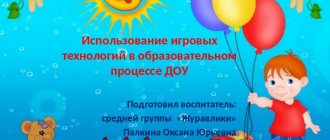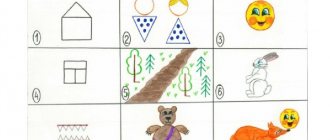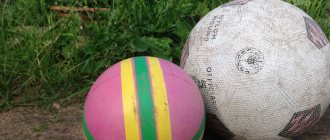MAGAZINE Preschooler.RF
WORK EXPERIENCE USING PEDAGOGICAL TECHNOLOGIES IN THE DEVELOPMENT OF CONNECTED SPEECH OF SENIOR PRESCHOOL CHILDRENMUNICIPAL PRE-SCHOOL EDUCATIONAL BUDGETARY INSTITUTION – CHILD DEVELOPMENT CENTER “KINDERGARTEN No. 12 “FIDGE”” Tynda, Amur Region
Getman T.I. teacher of the first qualification category, Tynda, April 2015.
The problem of speech development in preschool children is especially relevant today, because the percentage of preschoolers with various speech disorders remains consistently high. Children experience difficulties in sound pronunciation, in mastering lexical and grammatical forms, have a poor vocabulary and are unable to construct coherent statements.
According to the Federal State Educational Standard for Preschool Education (FSES DO): “speech development includes mastery of speech as a means of communication and culture; enrichment of the active vocabulary; development of coherent, grammatically correct dialogical and monologue speech; development of speech creativity; development of sound and intonation culture of speech, phonemic hearing; acquaintance with book culture, children's literature, listening comprehension of texts of various genres of children's literature; the formation of sound analytical-synthetic activity as a prerequisite for learning to read and write .
The requirements of the Federal State Educational Standard are the main guidelines for us. Full implementation of the goal is the formation by the end of preschool age of universal communication between the child and the people who surround him. An older preschooler should have no difficulty in talking with representatives of society different in age, social status, and gender.
The effectiveness of pedagogical influence depends on the child’s activity in terms of speech activity. The more active a child is, the more involved he is in activities that interest him. Traditional forms (a sample story from a teacher, memorizing a poem line by line, step-by-step examination and description) do not allow the child to sufficiently reveal his creative potential.
Today, the first priority is given to the task of child development, which will make the process of equipping preschoolers with knowledge, skills and abilities more effective. A development mindset can be considered a modern strategy for teaching the native language to preschool children.
It becomes obvious that it is necessary to change the way we work to develop the speech of preschoolers.
Of course, the choice of educational technology is determined by the age of the children, the goals and objectives that the teacher sets for himself and the children. Pedagogical innovations change and improve the learning process. Innovative technologies are aimed at developing creative abilities, developing a non-standard vision of the world, and new thinking.
In my teaching practice, I use pedagogical technologies aimed at developing mental abilities and creating a creative product in speech activity.
Mnemonics - “the art of memorization” - is a system of methods and techniques that ensure children’s successful acquisition of knowledge about the characteristics of natural objects, the world around them, effective memorization of the structure of a story, preservation and reproduction of information, and, of course, the development of speech.
Drops are ringing in the yard, streams are running through the fields, and there are puddles on the roads. The ants will soon emerge from the winter cold.
A bear makes its way through the dead wood. The birds began to sing songs, and the snowdrop began to bloom.
The use of mnemonics in teaching preschoolers allows you to solve problems such as:
- Development of coherent speech;
- Converting abstract symbols into images (transcoding information);
- Development of fine motor skills of the hands;
- Development of basic mental processes - memory, attention, imaginative thinking; Mastering the techniques of working with mnemonic tables helps and reduces training time.
- Visual modeling method
Sun, rain. (Spring weather.) Birch. (The appearance of the first buds.) Thawed patch. (Primroses in thawed patches.) Flock. (Migratory birds.)
Jerzy. (Awakening animals from hibernation.) Butterfly. (Insects appear.)
I invite the children to look carefully at the diagram: what happened first? What then? Where will you start your story? (each child has support diagrams on the sole; individual work is carried out: check if everything is clear).
Children take turns telling a short story, placing their sign on the easel.
“Spring is coming. The sun is shining brighter, the icicles from the roofs are “crying. The snow is melting, and snowdrops appear in the first thawed patches. Migratory birds return in flocks from warm countries. They build nests and hatch chicks. Animals are awakened from hibernation. The first insects appear."
When teaching coherent speech, modeling can be used to work on all types of coherent utterances:
- retelling
- compilation of stories based on a painting and a series of paintings
- descriptive story
- creative story.
Thanks to working with models, children learn to analyze, generalize, and identify essential features. In children, thought processes and mental processes are activated: memory, attention, thinking, logic develops, and coherent speech develops.
Gaming technologies
In play and through playful communication, a growing person develops and develops a worldview, a need to influence the world, and adequately perceive what is happening.
In the educational process with preschoolers I use:
- didactic games and exercises
- “Bring the subject to life” (you are asked to choose an object in the picture for discussion). Children determine his character, talk about his possible actions and thoughts. For example, a landscape is considered; children choose and characterize the object - spruce: calm, sleeping, breathing quietly. Drawing up speech sketches on behalf of a humanized object.
The tasks of a child’s speech development in kindergarten are solved as part of all educational activities with children. When children, in the process of mathematical development, become familiar with the “more” - “less” between numbers, with the dependence of the more - less relationships, complexity is created for them. I introduce the following game technique: “What do the numbers and figures say?” (4 -5-6), (7-, etc.: (I display magnetic numbers on the easel, the guys conduct a dialogue by reviving the numbers, numbers: example, number 5 - I am more than 4, but less than -6 and so on further).This technique activates cognitive and speech activity.
etc.: (I display magnetic numbers on the easel, the guys conduct a dialogue by reviving the numbers, numbers: example, number 5 - I am more than 4, but less than -6 and so on further).This technique activates cognitive and speech activity.
- Game exercise “Compare and name” . Goal: development of thinking, imagination, activation of speech activity, enrichment of vocabulary.
The sun is yellow like... (dandelion, chicken, lemon). The sun is round, like... (ball, orange, bun). The sun is gentle, like... (grandmother, mother, breeze, warm sea). The sun is cheerful, like... (song, clown).
The sun is warm, like... (stove, mittens, sweater) The sun is bright, like... (light bulb, lantern, star) The sun is hot, like... (fire, fire).
K. D. Ushinsky: “Exercises most of all prepare the child for learning grammar. Exercises are preferable with children of senior preschool and primary school age .
- Game exercise “Find relatives” . The goal is to highlight the properties of objects, find comparisons, expand vocabulary (author's development).
Thus, children learn mental operations (analysis, synthesis, comparison, generalization, etc.), with the help of which meaningful knowledge is acquired, systematized and used, which is effective both for the development of speech and for mental development in general.
Traditionally, in preschool childhood, working with riddles is based on guessing them. When developing a child’s mental abilities, it is more important to teach him to compose his own riddles than to simply guess familiar ones. In the process of composing riddles, all the child’s mental operations develop, and he receives joy from verbal creativity.
For this purpose, I use exercises such as “Description is a riddle” . Assignment: make a sentence about an icicle, knowing its signs and properties. Example: She is tearful, but not the Laughing Princess. It is long, but not a carrot, etc.
- discussions with children “What I wished for looks like (bow.) “can be associated with a flower, a butterfly, a helicopter rotor, with the number 8” ;
- warm-ups - divergent tasks: “What is common between...?” , "What does it look like?" , “Good - bad” (is the snow melting quickly?).
- Game exercise: “For what reason did two events happen?” Goal: to teach children to find a common cause, teach them to reason, and develop coherent speech. Integration of educational areas: cognitive and speech development.
- All passers-by got wet. – Finally, the first shoots came out of the ground.
- All the ice cream was sold out. – The boy’s back was burned.
- Many children got sick. - The windows are covered with frost.
- Speech game "Too much" . Goal: to teach children to reason and draw conclusions.
- If you eat one piece of candy, it’s delicious and pleasant. What if there is a lot?
- One tablet helps relieve pain, but what if you eat a lot of tablets?
- Tasks:
- How to brew tea?
- How to prepare cookie dough?
- Tell me how your mother cooks soup (borscht) at home?
By organizing such tasks with children, I solve the following tasks: teach children to plan the stages of their actions, justify their choices, develop and intensify speech activity.
Mastering one's native language is closely related to the development of a child's consciousness, knowledge of the world around him, and the development of all aspects of his personality.
The purpose of such tasks and game exercises is the development of a creative personality, capable of understanding the unity and contradiction of the surrounding world, and solving their small problems through communicative activities.
Play is one of the best ways to develop children's speech and thinking. It gives the child pleasure and joy, and these feelings are the strongest means of stimulating the active perception of speech and generating independent speech activity. They are so captivating and bring so much benefit!
- When using such tasks “Draw arrows with a pencil from what happened before to what will happen later” ; “Draw what will happen next” is integrated with visual activity: completing the task, the child pronounces the algorithm presented in the picture, thus, the problems of educational areas are solved in an integrated way: cognitive and speech development.
- board-printed games
Among pupils with problems in speech development, there is a high percentage of those who have problems with the development of gross and fine motor skills, memory, attention, and thinking.
To do this, I use health-saving technologies:
— articulatory warm-up: at the beginning of each lesson, I definitely organize a warm-up in order to get the children ready to work and train their articulatory organs, which is necessary for the correct pronunciation of sounds. I select warm-ups in accordance with the topic of the educational activity itself. Here, for example, on the topic “Spring” is the following warm-up:
Spruce-spruce-spruce - the ringing drops are ringing, Whose-whose-whose - fast streams are running, Ew-whew-whew - I'm making my own owl's nest, Wey-wey-wey - you're welcome, nightingale.
To do this, I have a selection of such warm-ups.
- finger gymnastics (mosquito song - s-z-z; water song - s-s-s; snake hissing - sh-sh-sh). In this case, finger gymnastics is carried out together with articulation (while pronouncing sounds, children perform finger gymnastics: the thumbs alternately meet with other fingers).
Systematic exercises to train finger movements stimulate the child’s speech development. S.A. Sukhomlinsky wrote that the origins of children’s abilities and talents are at their fingertips. From them, figuratively speaking, come the finest streams that feed the sources of creative thought. The more skill in a child's hand, the smarter the child.
— physical education minutes (if fatigue occurs, decreased performance, or loss of interest and attention, we include physical education minutes in the structure of the lesson). This form of physical activity is a necessary condition for maintaining high performance and maintaining the health of students. Each teacher has a selection of dynamic pauses and warm-ups in his arsenal. I also try to use them in accordance with the theme and type of GCD, thus, the selected dynamic pauses relieve children’s fatigue in the process of cognitive activity, and at the same time they do not lose interest in further work, and the logical chain is not interrupted. For example, a dynamic pause to the GCD on the theme “Spring - the morning of the year .
“The drops dripped loudly (light jumps) All the icicles cried (shaking their heads) We icicles are hot (waving their hands on our faces) Water is flowing from us (tilt down) We will melt forever (straightened up).
One of the health saving technologies is breathing exercises.
In my practice I use a variety of playful breathing exercises. So, during the “Spring Awakening of Nature” , they looked at the creative work of children done in a drawing class and included breathing exercises.
Breathing exercises: - Let's breathe in the aroma of snowdrops. (Take a deep breath through your nose; as you exhale, say “Oh, how wonderful the flower smells” ). Children say the phrase while exhaling 2-3 times.
In modern pedagogy there are still many technologies that can be used to develop the speech of preschool children. But there are certain rules for their use:
- Visual material offered to children should be accessible and understandable.
- You should strive to ensure that the material used (visual or demonstration) has an impact on the maximum possible number of senses.
- Obligatory reinforcement of the demonstration with speech. Speech explanation, combined with clarity, deepens comprehension and understanding of the subject of explanation.
- In the process of GCD, comprehensively solve the problems of speech development: the formation of sound culture, lexical and grammatical structure of speech, enrichment and activation of the dictionary.
It is impossible to solve the problems of speech development of a preschooler only in the process of direct educational activities. This work is carried out within the framework of all educational activities during the day.
Here I use TRIZ technology when working with children
The PURPOSE of use is to instill in a child the joy of creative discovery.
THE MAIN CRITERION in working with children is clarity and simplicity in the presentation of material and in the formulation of a seemingly complex situation.
In the educational activities of the regime moments, I organize such a game “Guess the substance” (with models of aggregate states of substances).
Rule of the game: (organized when children are familiar with diagrams-models of aggregate states of substances). During the game, children's activities are integrated: cognitive-speech, play, and motor activities.
Competition games such as “WHAT IS MADE OF WHAT?”
Rules of the game: the winner is the one who correctly and quickly - in 1 minute (I set an hourglass) names the materials from which the objects are made, and says what they are all called in one word (example: ball - rubber, car - metal, cube - wooden , pyramid - plastic - these are toys)
Material: cards with images of all kinds of objects.
Option 1: (show items made from fabric, metal, glass, wood, plastic, rubber, etc.)
Option 2 (complication): (The child describes the object and names the material from which it is made, and then names what other materials such an object can be made from).
Thus, as a result of educational activities using the above educational technologies, children’s feelings of constraint are relieved, shyness is overcome, and the logic of thinking, speech and general initiative gradually develops.
| Next > |




